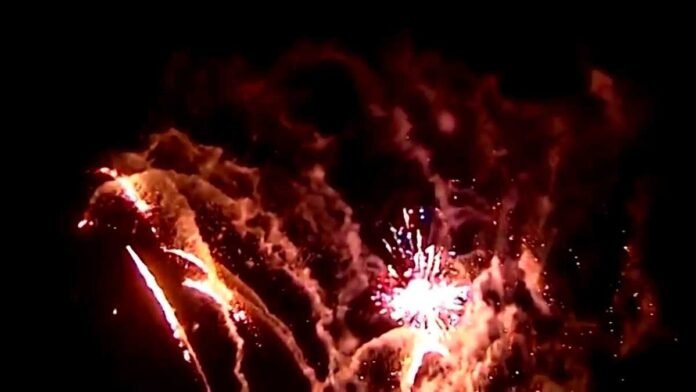GOTTA LOVE THEM. THOSE 4TH OF JULY FIREWORKS ARE GOING TO SOON START LIGHTING UP THE SKY. BUT HOW DO THEY GET THOSE BRIGHT COLORS WE KNOW AND LOVE? METEOROLOGIST SABRINA BATES JOINING US FOR THIS WEEK’S STEM SPOTLIGHT TO EXPLAIN HOW THIS WORKS. I LOVE THIS ONE, SABRINA. AND THIS WEEK’S STEM SPOTLIGHT. WE ARE LITERALLY WATCHING SCIENCE SCIENCE EXPERIMENT RIGHT IN FRONT OF US ON INDEPENDENCE DAY. AND JUST SCIENCE IS SO COOL. MANY OF US ARE GOING TO GO TO FIREWORKS SHOWS THIS WEEK, AND I’M THINKING, WHAT BETTER WAY TO BRING SCIENCE HOME YOU CAN SHARE WITH YOUR KIDS WHILE WATCHING THE SIZZLES AND THE SNAPS THAT FIREWORKS ARE REALLY CHEMISTRY IN ACTION NOW. FIREWORKS WILL LIGHT UP THE SKY THIS JULY 4TH, AND EVERY DAZZLING COLOR IS CREATED BY UNIQUE CHEMICALS FROM MINERALS. AND THESE ARE ELEMENTS THAT WE KNOW, LIKE SODIUM OR COPPER. SO HOW DO WE GET THE RED, WHITE AND BLUE COLORS THAT WE LOVE TO SEE EVERY 4TH OF JULY? HERE’S THE SCIENCE BEHIND IT. USGS SAYS THAT THE FIERY RED FIREWORKS COME FROM AN ELEMENT THAT SOUNDS SUPER SCIENCY. IT’S STRONTIUM, BUT THIS IS WHERE IT GETS PRETTY COOL. THE BRILLIANT WHITE LIGHTS COME FROM TITANIUM OR MAGNESIUM, AND MY FAVORITE, THE BRILLIANT BLUES. THOSE ACTUALLY COME FROM COPPER. WE TALKED TO AN EXPERT ABOUT HOW ALL OF THIS WORKS TOGETHER. THE COLORS THAT YOU SEE ARE DIFFERENT CHEMICALS COMBINED TO MAKE USUALLY LITTLE TINY BALL STARS INSIDE THE DEVICE. AND THOSE LITTLE TINY BALL STARS WHEN THE SHELL EXPLODES IN THE AIR, IT IGNITES THOSE LITTLE STARS AND THEY BURN FOR A, YOU KNOW, SPECIFIC TIME LENGTH THAT THEY’RE MANUFACTURED TO DO SO. AND THAT’S WHERE YOU GET YOUR COLOR EFFECT FROM. NOW INDEPENDENCE DAY, FIREWORKS ARE MORE THAN THE SPARKLES AND THE LOUD BANGS. IT IS SCIENCE HAPPENING RIGHT BEFORE OUR EYES. AND DANNY ALSO STRESSES, OF COURSE, HOW IMPORTANT SAFETY IS WHEN BEING AROUND. FIREWORKS FOR THE FOURTH OR REALLY ANY TIME OF YEAR. NOW REMEMBER TO SHARE THIS WITH YO
The science behind Fourth of July fireworks colors
KOCO 5 Meteorologist Sabrina Bates explains the chemistry behind the vibrant colors of Fourth of July fireworks.
KOCO 5 Meteorologist Sabrina Bates explains the chemistry behind the dazzling colors of Fourth of July fireworks, highlighting that each color is created by unique chemicals from minerals.>> Download the KOCO 5 app | Subscribe to KOCO 5’s YouTube channelBates notes that elements like sodium and copper are responsible for the vibrant hues seen during the celebrations.The fiery red fireworks are produced using strontium, an element that Bates describes as “super science-y.” Meanwhile, the brilliant white lights are created from titanium or magnesium.Bates shares her favorite, the brilliant blues, which come from copper.”It takes a lot — safety and distances — different kinds of safety features,” said Danny Bonanno, president of Oklahoma Pyrotechnics Club. “The colors you see are chemicals combined and when it explodes into little stars and you see colors,” Bonanno said.Bonanno also noted the chaotic nature of this time of year, balancing a full-time job and family commitments.”Very chaotic this time of year with my wife and I having a full-time job and my kids in college — it’s an all-year process just at the stands,” he said.Get the latest news stories of interest by clicking here.Bates encourages viewers to appreciate the science behind the fireworks, suggesting that Independence Day fireworks are more than just sparkles and loud bangs. She urges people to share this knowledge with their kids while watching the fireworks. Watch the video above for more.Top HeadlinesOKC metro doctor arrested on murder complaint after 4-year-old daughter drowned in FloridaFewer Americans will host cookouts this Independence Day. Here’s whySean ‘Diddy’ Combs acquitted of most serious charges, convicted of prostitution-related offensesCourt records: Father who killed daughter, then himself, has history of violenceOHP releases identity of 63-year-old man killed in aircraft crash near Guthrie
KOCO 5 Meteorologist Sabrina Bates explains the chemistry behind the dazzling colors of Fourth of July fireworks, highlighting that each color is created by unique chemicals from minerals.
>> Download the KOCO 5 app | Subscribe to KOCO 5’s YouTube channel
Bates notes that elements like sodium and copper are responsible for the vibrant hues seen during the celebrations.
The fiery red fireworks are produced using strontium, an element that Bates describes as “super science-y.”
Meanwhile, the brilliant white lights are created from titanium or magnesium.
Bates shares her favorite, the brilliant blues, which come from copper.
“It takes a lot — safety and distances — different kinds of safety features,” said Danny Bonanno, president of Oklahoma Pyrotechnics Club. “The colors you see are chemicals combined and when it explodes into little stars and you see colors,” Bonanno said.
Bonanno also noted the chaotic nature of this time of year, balancing a full-time job and family commitments.
“Very chaotic this time of year with my wife and I having a full-time job and my kids in college — it’s an all-year process just at the stands,” he said.
Get the latest news stories of interest by clicking here.
Bates encourages viewers to appreciate the science behind the fireworks, suggesting that Independence Day fireworks are more than just sparkles and loud bangs. She urges people to share this knowledge with their kids while watching the fireworks.
Watch the video above for more.
Top Headlines







